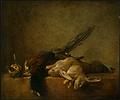Tour: 18th-Century France — Chardin and Portraiture
| Overview | Start Tour | ||
 |
 |
 |
| 1 | 2 | 3 |
 |
 |
 |
| 4 | 5 | 6 |
| » | next | |||
| « | back to French and Italian painting of the 18th century | |||
Overview
The Academy
The Royal Academy of Painting and Sculpture was established in 1648 to centralize control over the arts, and in eighteenth-century France it dominated artistic life. Only members could receive royal commissions or participate in the official Salons, the Academy's influential exhibitions.
Full membership required the Academy's acceptance of an artist's "masterpiece." Painters were received as specialists in a particular type of painting. In the strict hierarchy promoted by the Academy, "history painting," which included religious, mythological, and historical subjects, was the most highly esteemed. Next came portraiture, then landscape and still life. This ranking suggested that some types of painting required an artist to use his mind as well as his eyes.
(continue)
Captions


